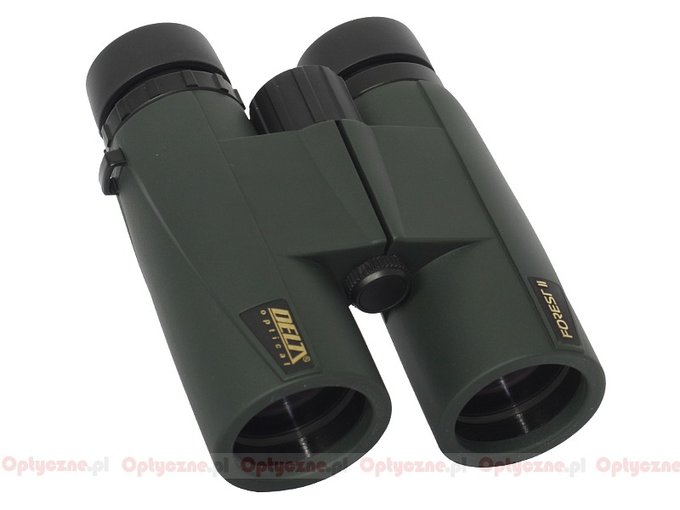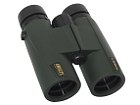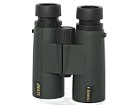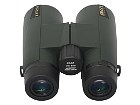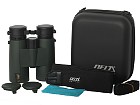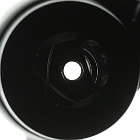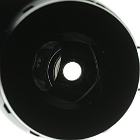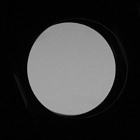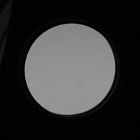Delta Optical Forest II 8x42
The Delta Optical Forest II binoculars are roof prism devices with BaK-4 glass prisms. At this price point it would be difficult to count on something more than ordinary aluminum layers covering Schmidt-Pechan prisms but the producer emphasizes the fact that all air-to-glass surfaces are multi coated.
You can get 8x42 and 10x42 binoculars in this series, all of them waterproof and nitrogen-filled. Buyers also can find objective caps a rainguard, a strap, a hard case with another strap and a cleaning cloth in the accessory kit. The binoculars come with a two-year warranty period of the producer.
| Magnification | Lens diameter | Angular field of view | Prisms | Eye relief | Weight | Price |
|---|---|---|---|---|---|---|
| 8 | 42 | 150/1000(8.52o) | BaK-4/roof | 17 mm | 710 g | 459 PLN |
Summary
Pros:
- stylish and solid casing at such a price point,
- very wide field of view for 8x42 parameters,
- decently corrected chromatic aberration,
- very low astigmatism,
- moderate coma,
- right blackening and cleanliness inside the tubes,
- good quality prisms made of BaK-4 glass,
- sensible price/quality ratio.
Cons:
- field of view much narrower than stated in the specifications,
- huge fuzzy area near the edge of the field of view,
- average transmission,
- too high distortion level,
- egg-shaped exit pupils,
- maximum gauge of eyepieces a bit too narrow.
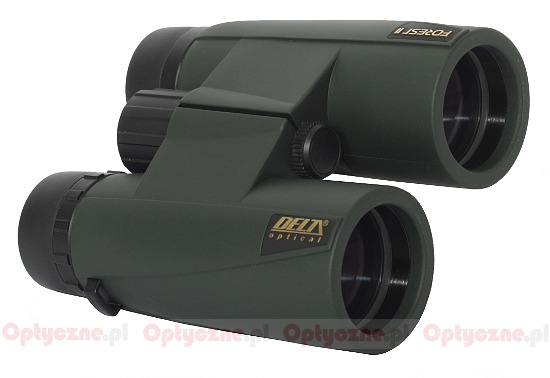 |
The overtone of this summary might differ depending on your expectations. If you believed Delta Optical was capable of miracles, the results of the new Forest II could disappoint you. If you are a realist and you are aware that a 8x42 roof prism instrument with a price tag of 100 Euro must entail a lot of compromises, the final score could be perceived as optimistic.
We deal here with a nice-looking, quite handy 8x42 instrument which is well-made, fully waterproof and features a field of view wider than most similar, and often much more expensive, rivals. It offers BaK-4 prisms and its results in many important categories (like the coma, astigmatism, chromatic aberration or darkening inside the inner tubes) are really decent. What’s more, Delta Optical managed to launch a successor which is not significantly more expensive than the older version and still has much better parameters (the field of view increased by over 1 degree and the minimum focus decreased by about 1 meter) and optical and mechanical properties as well (it is even submersible). It would be really difficult to expect much more. As we wrote previously at this price point there have to be some compromises and we can’t omit them in our summary. First let’s glance shortly at a transmission graph.
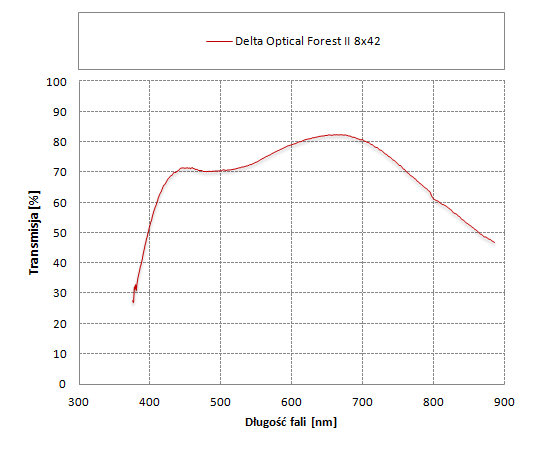 |
These achievements lack a lot in order to be called good. I understand that in this price segment it would be difficult to expect dielectric coatings on prisms and we must make do with simple aluminum ones which have losses on the level of 10-12%. If on every air-to-glass surfaces decent multi-layered coatings had been applied, the transmission could have been by several percent higher. The current result and a lot of light reflected in the prisms suggest that somewhere there are no coatings or simple single-layer coatings were used, not adapted well to the refraction ratio of the glass they cover.
You cannot omit truncated eye pupils which, at the very start, take away 4-5 % of light. Combining it with at most an average transmission and you can find why there are really a lot of losses.
The field of view is quite a separate topic. Let’s just compare the performance of the most renowned rivals in this category – the following chart will make it easier. None of these excellent pairs of binoculars offers a field of view wider than 8 degrees. In fact a field bigger than 8 degrees can be found only in 8x40 Porro devices. When it comes to roof-prism 8x42 instruments you can count binoculars with a field of view of bigger than 8 degrees using just the fingers of your one hand. Small wonder those 8.5 degrees, declared by Delta Optical, looked suspicious and it turned out the real field is by as much as 0.4 of a degree narrower. It is a bit dishonest and not very nice, especially that a field of 8.1 on the casing would look not less impressing. I would like to write even more. While designing such a pair of binoculars I wouldn’t try to bite off more than I can chew and I wouldn’t decide to have a field of view of over 8 degrees – I would rather aim at something around 7.5-7.8 degrees. Such a result would still place the Forest II at the top in this category and a slightly limited field would allow to reduce an area of significant fuzziness on the edge; it would also help decrease the level of coma, distortion or lateral chromatic aberration.
Perhaps the producer would be also able to avoid another slip-up – the significantly egg-shaped eye pupils. The conclusion seems to be rather straightforward – when you are constructing a cheap pair of binoculars, involving a lot of compromises, you shouldn’t try to achieve extreme values of particular parameters at all. It is perhaps the only serious reservation you can have in the case of the Forest II. Other slip-ups are redeemable because it is really a nice and pretty device, offered at an affordable price.




